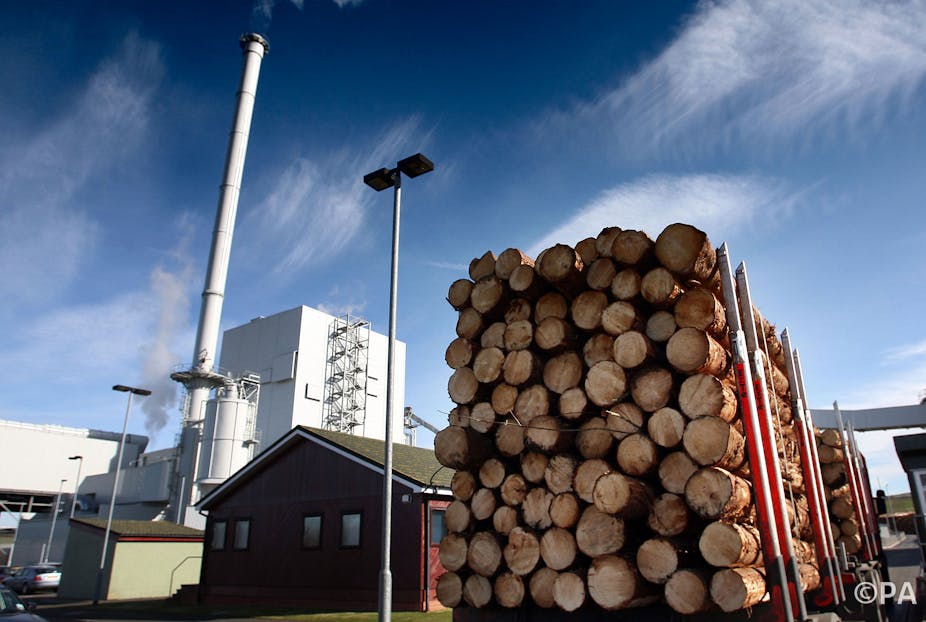Many countries have turned to the planet’s forests to meet their need for renewable energy, burning wood chips and pellets produced at home or abroad in power stations to generate electricity. But a report from the European Environment Agency published this week urged caution over what to burn, and how.
There’s no question that if managed sustainably - which absolutely rules out turning tropical forests into palm oil plantations – wood-powered bioenergy can be an effective renewable energy source. In some cases, wood energy markets even encourage good forestry practice that can improve forest health and reduce fire and insect risks. And many experts agree that high yield, short rotation plantations of fast-growing willow or poplar make sense, depending on the land-uses these operations displace.
But the question of whether wood bioenergy is problematic from a climate change perspective is much harder to answer. If we burn wood from a forest to produce heat or electricity or both, would the carbon emissions be re-sequestered as the forest re-grows? Is it accurate to consider wood biomass energy to be carbon neutral in terms of greenhouse gas emissions?
Forest carbon is sequestered - soaked up from the atmosphere - by plants through photosynthesis, stored in living and dead biomass, and ultimately released back to the atmosphere in the form of carbon dioxide through plant and animal respiration and decomposition. This might suggest that the carbon locked up in forests is part of a global biogenic carbon cycle, separate and distinct from that humans have released by burning fossil fuels.
It seems simple, intuitive even, but it’s not that straightforward. Even the concept of “biogenic carbon” is disputed. In our paper we contended that the concept of biogenic carbon is a red herring, because what really matters is the net amount of carbon in the atmosphere, regardless of source. Others will adamantly disagree.
In many cases, poorly supported assumptions continue to underpin a sudden rush to develop wood bioenergy power generation around the world - often backed by subsidies. In my opinion, policies promoting wood bioenergy have developed quicker than the science that examines the potential trade-offs, net effects and consequences. Science needs time to explore the complexities of an issue like bioenergy. Only through proper study can the scientific community provide more informed answers to important policy questions.
The crux of the debate comes down to whether or not there will be an initial increase in greenhouse gas emissions if more wood is used for bioenergy (a carbon “debt”), particularly if it is harvested from growing trees, followed by a delay before a net emissions reduction is achieved (the “dividend”). And if so, how long that delay would be. This was the structure of the argument laid out in a now infamous study conducted for the state of Massachusetts in the US.
A 2011 paper found immediate emissions benefits from using biomass leftover from harvests or from plantations established on marginal agricultural land, assuming biomass was substituted for coal and gas. But intensified harvesting of existing forests was projected to incur a carbon debt lasting many decades. Generating thermal energy instead of electricity has been shown to incur much shorter debt, for example.
Getting this right is vital, because we have a window of only the next few decades to stabilise atmospheric greenhouse gases, beyond which some scientists believe climate disruption will be irreversible.
So, assuming there will be some degree of debt in the near future and a consequent time lag before an overall net reduction of emissions, we can minimise both by following certain practises. Using by-product or waste biomass, that does not involve intensive forest harvesting, practising excellent sustainable forestry techniques, and building small-scale, highly efficient energy generation applications with minimal waste.
Policies should promote high-efficiency energy applications, such as combined heat and power. Studies have found smaller bioenergy projects such as those for homes, housing estates or municipal buildings have much lower net emissions than large, industrially-sized plants. The choice of what not to use is just as important - substituting wood for coal eliminates considerably more carbon emissions than substitution for natural gas.
My research group, using data from bioenergy harvests and energy production across the northeastern United States, came to completely different conclusions depending on the baseline used as a reference to evaluate net emissions. The results swung from carbon negative to carbon positive if the baseline used was the amount of carbon that would have been sequestered had wood bioenergy not been used (with all other things being equal, and taking into account avoided emissions and direct and indirect energy uses associated with wood harvesting). Conversely, if the baseline is simply the amount of carbon currently being emitted at the present date, then most forest management schemes, including wood bioenergy, lowered carbon emissions over the long term. This was true so long as they incorporated the principles of sustainable harvest scheduling that maintain stable forest levels to stock carbon across the landscape as a whole.
Should we stop investing in and promoting wood bioenergy? No - but we should proceed with caution, using the best available science. Policymakers will need to weigh the benefits and trade-offs to minimise unintended consequences such as emissions increasing in the short-term.
Go local, go small scale, go high efficiency, and develop rigorous forest harvesting standards and guidelines. When it comes to wood bioenergy, it is unlikely we will be able to have our cake and eat it too.

